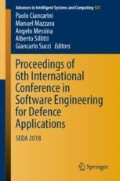Abstract
Historically, because of regulatory constraints systems focused only on hardware and software safety, and considered security independently as an add-on, if anything required.
But, it is widely recognized safety-critical systems today are quite certainly security-critical too, as well as safety and security functions may influence each other. It also happens that the system’s usage context is not completely known nor understood at development time which means system maintenance will not just limited to bug-fixes and will involve continuous hazard analysis. Especially in Avionic and Automotive sectors, the growing awareness of conjoint safety and security pushed the research new paradigms for design, development, verification and validation, and the promotion of holistic methods and techniques for conducting safety and security co-engineering, co-assessment and certification/qualification. Finally, there is not a standard that provides conjoint guidelines for the safety and security domains so that compliance to multiple standards is currently the used approach.
This paper focuses briefly on the safety and security real-time operating systems, the architecture they are required to provide for addressing safety and security, and the applicable standards. It then highlights how a real-time GNU/Linux OS can be included in a formal certification package as demanded by SIL2 applications that meet the IEC 61508 requirements, and how such operating system should be improved for use into interconnected systems.
Access this chapter
Tax calculation will be finalised at checkout
Purchases are for personal use only
References
Report, MERgE Safety and Security, ITEA2 Project # 11011 Recommendations for security and safety co-engineering. Document version 1.0
Magazine, ERCIM News Trustworthy systems of systems safety & security co-engineering. Number 102, July 2015. https://ercim-news.ercim.eu/images/stories/EN102/EN102-web.pdf
Schoitsch E, Skavhaug A ERCIM/EWICS/ARTEMIS workshop on dependable embedded and cyberphysical systems and systems-of-systems, September 2014. https://www.researchgate.net/publication/289935138_Introduction_ERCIMEWICSARTEMIS_Workshop_on_Dependable_Embedded_and_Cyberphysical_Systems_and_Systems-of-Systems_DECSoS’14_at_SAFECOMP_2014
Schmittner C, Ma Z, Puschner P (2016) Limitation and improvement of STPA-Sec for safety and security co-analysis. In: SAFECOMP 2016 conference
Kiesling T, Kreuzer M (2017) ARIEL – Air Traffic Resilience Recommendations to strengthen the cyber resilience of the air traffic system, version 2.0
ARINC Specification 653P0-1 Avionics application software standard interface, part 0, overview of ARINC 653, 1 August 2015. https://www.aviation-ia.com/products/653p0-1-avionics-application-software-standard-interface-part-0-overview-arinc-653-2
RTCA Document DO-178C Software Considerations in Airborne Systems and Equipment Certification. https://www.rtca.org/content/standards-guidance-materials
ISO/IEC 15408-1:2009 Information technology – security techniques – evaluation criteria for IT security – part 1: introduction and general model. https://standards.iso.org/ittf/PubliclyAvailableStandards/c050341_ISO_IEC_15408-1_2009.zip
EURO-MILS Consortium Secure European virtualisation for trustworthy applications in critical domains, October 2012. http://euromils.eu/downloads/2014-EURO-MILS-MILS-Architecture-white-paper.pdf
EURO-MILS Consortium, Common Criteria Protection Profile (2016) Multiple independent levels of security: operating system, V2.03. http://www.euromils.eu/downloads/EURO-MILS-Protection-Profile-V2.03.pdf
IEC 61508 Functional safety of electrical/electronic/programmable electronic safety-related systems, parts 1 to 7, Edition 2010. https://www.iec.ch
ISO 26262 Road vehicles – functional safety, parts 1 to 12, Edition 2018. https://standards.iso.org
IEC 62061 Safety of machinery - functional safety of safety-related electrical, electronic and programmable electronic control systems, Edition 2005. https://www.iec.ch
IEC 62278 Railway applications - specification and demonstration of reliability, availability, maintainability and safety, Edition 2002. https://www.iec.ch
ISO 10218 Robots and robotic devices – safety requirements for industrial robots, parts 1 to 2, Edition 2011. https://standards.iso.org
IEC 61511 Functional safety - safety instrumented systems for the process industry sector - part 1: framework, definitions, system, hardware and application programming requirements, Edition 2016. https://www.iec.ch
IEC 62304 Medical device software - software life cycle processes, Edition 2006. https://www.iec.ch
AUTOSAR Development Partnership Requirements on AUTOSAR Features, Release 4.3.1. https://www.autosar.org/fileadmin/user_upload/standards/classic/4-3/AUTOSAR_RS_Features.pdf
Report, CSE International Limited for the Health and Safety Executive 2002 (2002) Preliminary assessment of Linux for safety related systems, Research Report 011
Mc Guire N (2007) Linux for safety critical systems in IEC 61508 context. https://www.osadl.org/fileadmin/dam/presentations/61508/61508_paper.pdf
Open Source Automation Development Lab eG (OSADL) Homepage. https://www.osadl.org/. Accessed 1 July 2019
OSADL-SIL2LinuxMP Homepage. http://www.osadl.org/SIL2LinuxMP.sil2-linux-project.0.html. Accessed 1 July 2019
Platschek A, Mc Guire N, Bulwahn L (2018) Certifying Linux: lessons learned in three years of SIL2LinuxMP
Linux Containers (LXC) Homepage. https://linuxcontainers.org/. Accessed 1 July 2019
Alves-Foss J, Rinker B, Taylor C (2002) Towards common criteria certification for DO-178B compliant airborne software systems. University of Idaho
Brosgol BM (2008) Safety and security: certification issues and technologies
Author information
Authors and Affiliations
Corresponding author
Editor information
Editors and Affiliations
Rights and permissions
Copyright information
© 2020 Springer Nature Switzerland AG
About this paper
Cite this paper
Procopio, G. (2020). Safety and Security in GNU/Linux Real Time Operating System Domain. In: Ciancarini, P., Mazzara, M., Messina, A., Sillitti, A., Succi, G. (eds) Proceedings of 6th International Conference in Software Engineering for Defence Applications. SEDA 2018. Advances in Intelligent Systems and Computing, vol 925. Springer, Cham. https://doi.org/10.1007/978-3-030-14687-0_22
Download citation
DOI: https://doi.org/10.1007/978-3-030-14687-0_22
Published:
Publisher Name: Springer, Cham
Print ISBN: 978-3-030-14686-3
Online ISBN: 978-3-030-14687-0
eBook Packages: Intelligent Technologies and RoboticsIntelligent Technologies and Robotics (R0)

